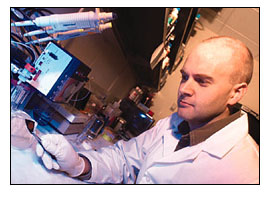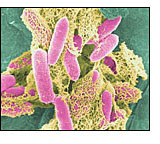ROCHESTER, N.Y., March 9, 2006 -- By creating a sensing system that includes a protein sample from a bacteria, a silicon chip and a digital camera, University of Rochester Medical Center scientists have demonstrated a new technology that accurately and rapidly detects dangerous E. coli bacteria. The researchers say the technology could one day help doctors to quickly confirm bacterial infections during a patient's office visit, a process that can take days now.
“We’ve developed a very inexpensive technology that can detect an infectious agent,” said Benjamin Miller, an associate dermatology professor at the medical center who is part of the university’s Center for Future Health. “It’s clearly faster and cheaper than any competing technology. This is another step on the way to point-of-care diagnostics.” It potentially could detect any biological entity, he said.

Benjamin Miller works in the lab. He and a research team at the University of Rochester Medical Center have developed a sensing system that can quickly detect infectious agents. (Photo: University of Rochester)
The Rochester research team calls the technology “arrayed imaging reflectometry.” The system uses a silicon chip that is made so that laser light reflected off of it is invisible unless the target bacteria are present. The target described in the article, which appeared last month in the journal Biosensors and Bioelectronics, is the sometimes deadly bacteria Escherichia coli, commonly known as E. coli.
A protein from the bacteria -- translocated intimin receptor or TIR -- is placed on the chip. The TIR can be seen as a “molecular harpoon,” Miller said. The E. coli sends out the harpoon into a cell. Once it is in the cell, the TIR then binds with an E. coli protein called Intimin. A similar process occurs between the TIR placed on the chip and any E. coli in the sample being tested. The binding of the probe and the bacteria alters the surface of the chip. A digital camera image of the chip captures the changes for analysis and confirmation of detection.

E. coli bacteria.
Traditional methods of bacteria detection can take days. “This takes as much time as it takes for a snapshot,” Miller said. The scientists currently are defining the sensitivity levels of the technology, previously called reflective interferometry, and extending the system to other biological targets.
Miller's biosensor technology article co-authors include Lewis J. Rothberg, professor of chemistry and member of the Center for Future Health; Scott R. Horner, chief technical officer for Pathologics; and Charles R. Mace, a University of Rochester biophysics doctoral student.
Research for the work was supported by grants from the US Department of Energy and the National Institutes of Health. Pathologics, a Rochester area startup company, was launched to further develop and commercialize the technology, with Miller, Rothberg and Horner having a financial interest in the business. For more information, visit: www.urmc.rochester.edu/pr/research/index.cfm